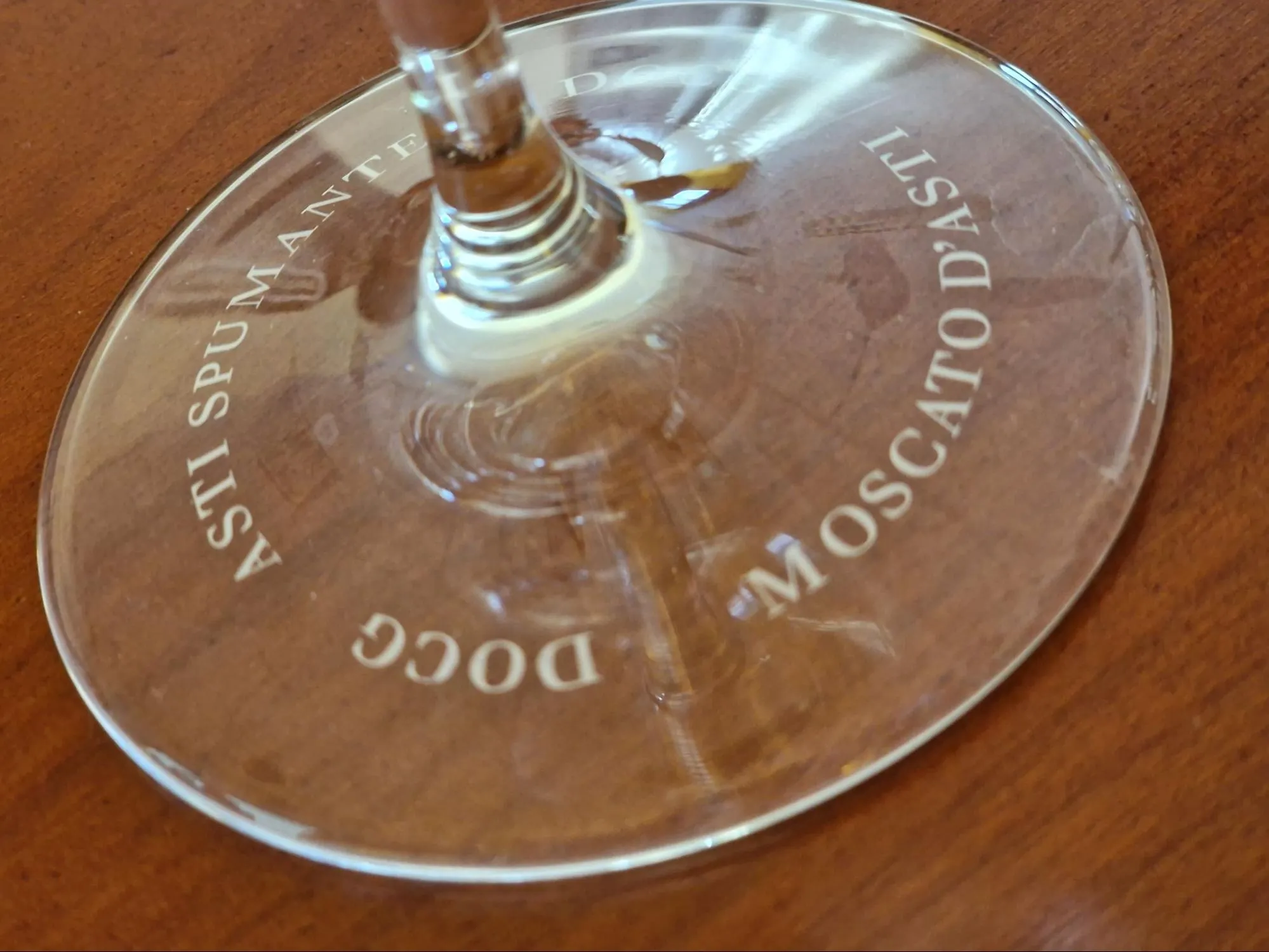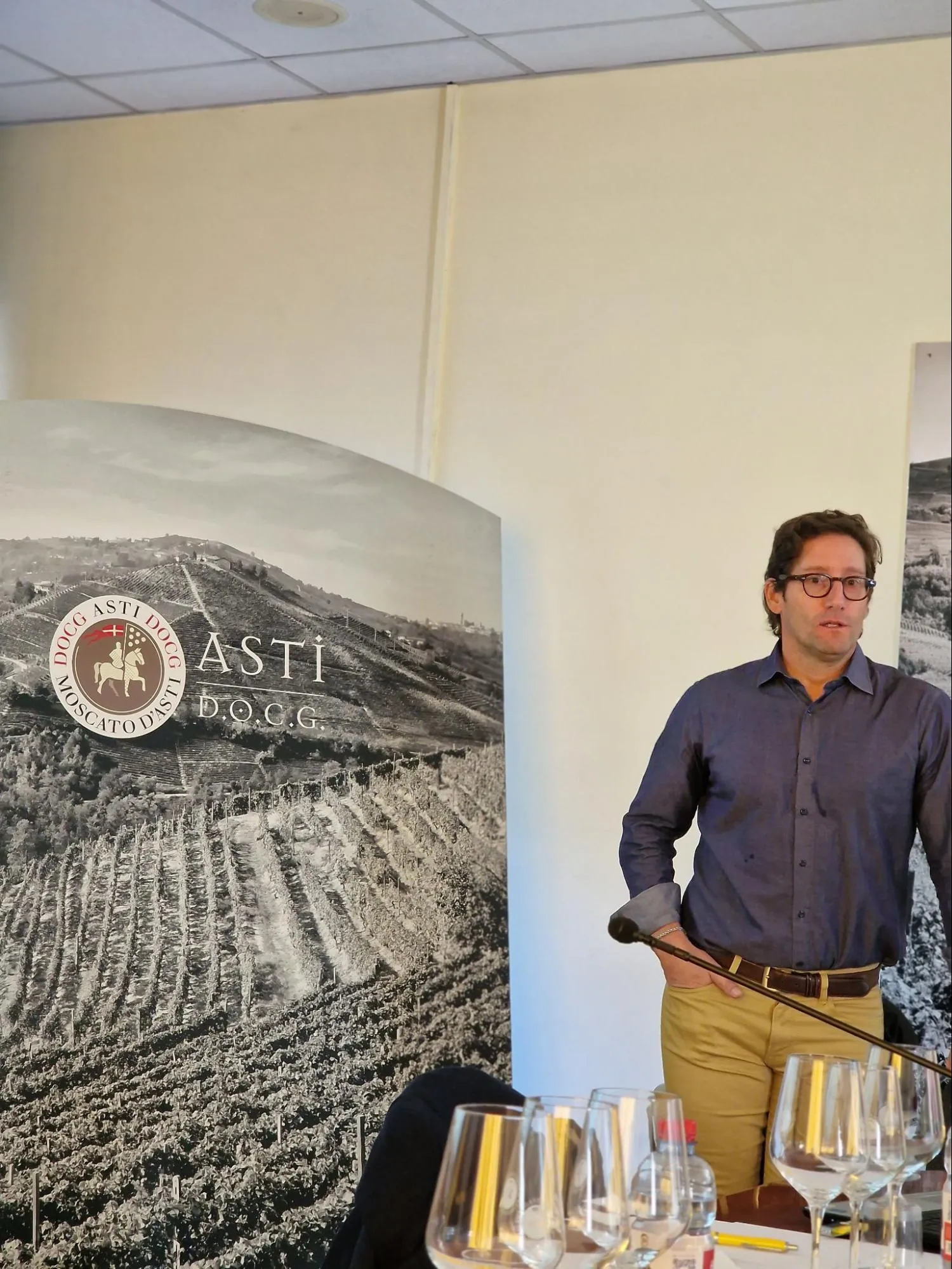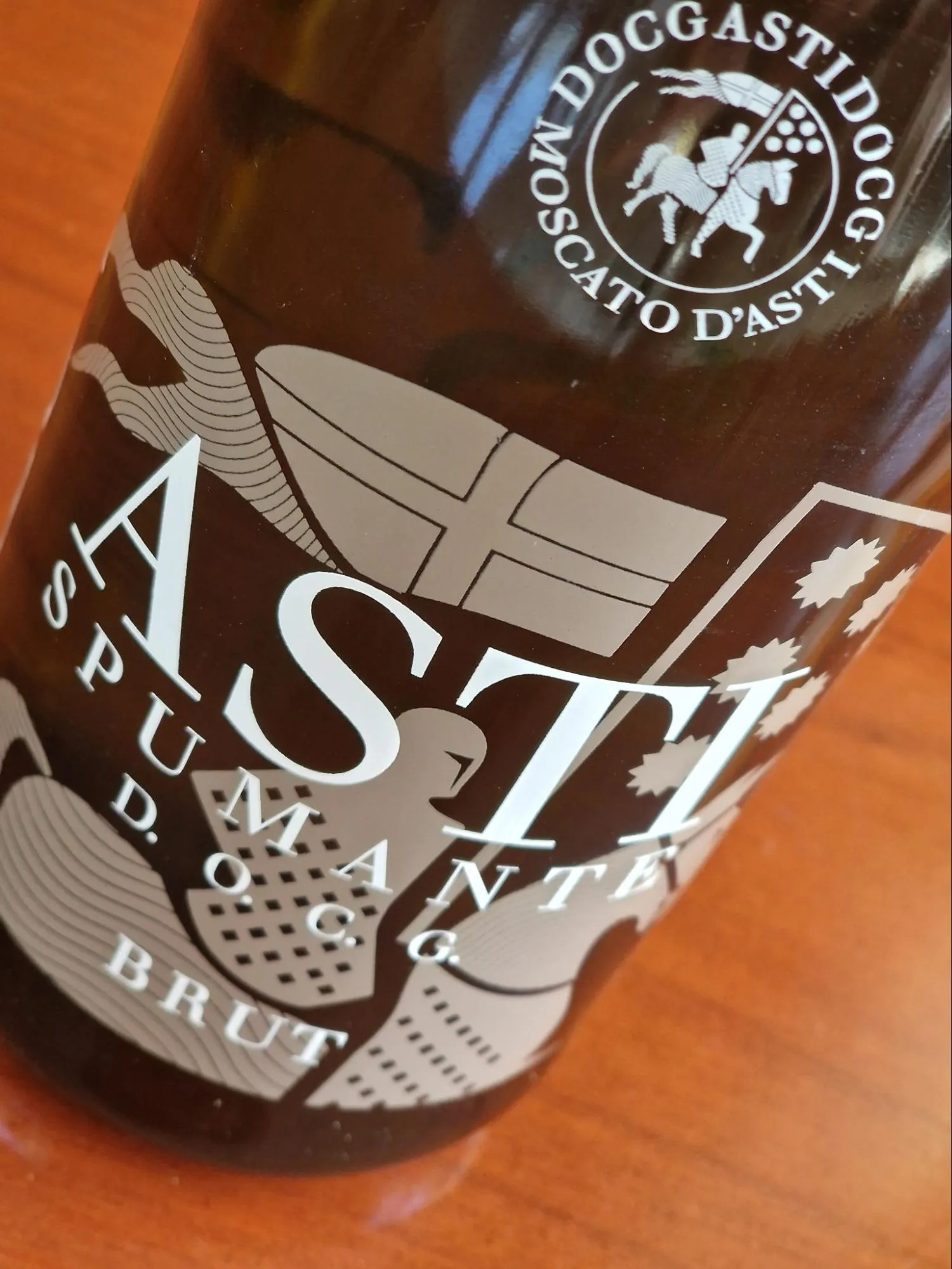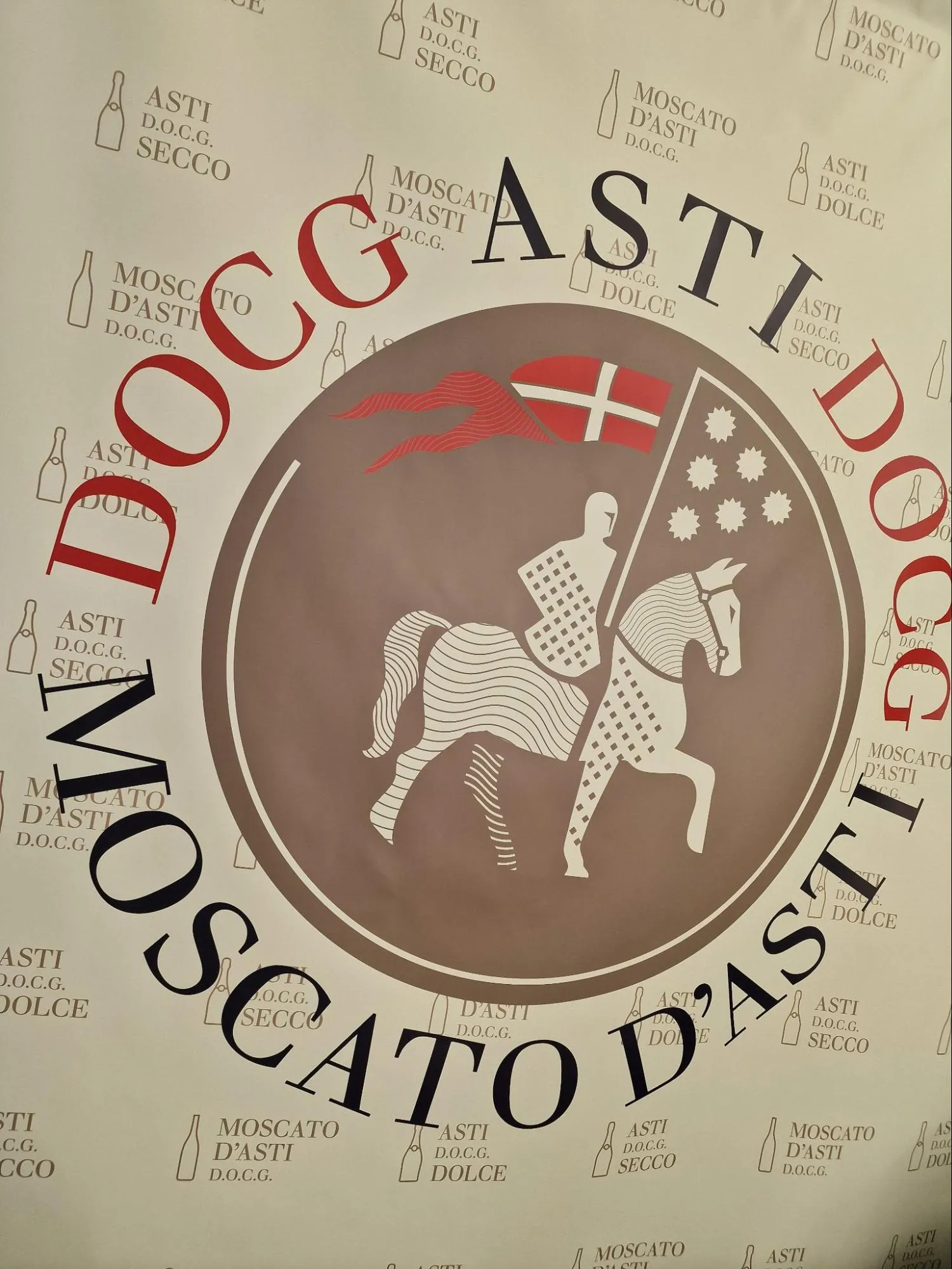- Wine Color/Type
- Top Occasions
- Unique Wines
- Surprise Me!
The sparkling side of Asti – Day 1
Discovering Asti's Astounding Sparkling Wines
At VinoVoss we are thrilled to continue our Asti journey, exploring the exceptional world of Italian sparkling wines. On the first official day of our Asti tour, we had the opportunity to attend a masterclass hosted by Giacomo Pondini, the Director of the Consorzio per la tutela dell'Asti. So here's a little recap of what we got to learn about this region and its delicious sparklings.
In the meantime, you can find out here what happened during our eventful arrival!
Wineglass of the Consorzio per la tutela dell'Asti sets the scene for an amazing tasting (Photo: Lotte Gabrovits)
Into Asti's D.O.C. and D.O.C.G. Recognition
Our masterclass began with a fascinating dive into the history of Asti's wine production. The Denominazione di Origine Controllata (D.O.C.) recognition was granted in 1967, acknowledging the region's viticultural significance. In 1993, the coveted Denominazione di Origine Controllata e Garantita (D.O.C.G.) status was achieved, elevating Asti's wines to a higher quality tier.
The Asti wine region is renowned for producing two distinctive styles of sparkling wine: Asti Spumante and Moscato d’Asti. Our journey led us through the world of these renowned wines, unravelled by Giacomo Pondini's expert guidance.
Giacomo Pondini, the Director of the Consorzio per la tutela dell'Asti (Photo: Lotte Gabrovits)
Asti Spumante Brut 2022: A Symphony of Bubbles
Our exploration started with Asti Spumante Brut, a wine with a complex, two-step fermentation process made of Moscato Bianco, which is known as aromatic grape variety. The first fermentation takes place in stainless steel tanks, while the second, which imparts the characteristic sparkle, occurs in the bottle, yielding a moderate alcohol content of 11,5 % abv. This double fermentation method is known as Metodo Classico, the same method used in Champagne! This wine's residual sugar content in this case is around 8-9 grams per liter, providing the ideal balance for this delightfully effervescent wine. Asti Spumante shines in the glass with its straw-colored hue. Its bouquet tantalizes the senses with notes of sage, lime, pear, thyme, and herbal undertones. The wine's elegance and density are perfectly complemented by refreshing acidity. As it graces your palate, you'll find the lack of bitterness in the finish, a characteristic feature that sets it apart from other sparkling wines. This is thanks to the fact, that Moscato Bianco only experiences little maceration on the skins as all the aroma compounds are found in the pulp, according to Pondini. The soft pressing process ensures that the wine's color remains lightly extracted, contributing to its remarkable body and flavor profile.
Asti Spumante Dolce 2022: A Sweet Balance
Our journey through Asti's sparkling treasures continued with the Asti Spumante Dolce 2022, a wine that tantalizes the taste buds with its opulent sweetness fermented from Moscato Bianco. With a residual sugar content ranging from 80 to 100 grams per liter and an alcohol level of 7-8% abv, this wine boasts a uniquely intense character. To produce such a wine, the Martinotti method is used, which is no other than the Charmat one. The wine is fermented in a stainless steel tank, and cooled down to stop the fermentation and leave some of the beautiful grape sugars behind. Its reductive, saline, and slightly metallic nose evolves into a symphony of balsamic, acacia, and floral notes. Hints of sage and herbal bonbons add complexity to its aromatic profile, creating a delightful and flavorful experience.
Asti Spumante D.O.C.G. does not have to be sweet (Photo: Lotte Gabrovits)
Moscato d’Asti 2022: The Nectar of the Gods
Our masterclass reached its zenith with Moscato d’Asti, a true nectar of the gods.
Similarly sweet or even sweeter than the Asti spumante Dolce with a residual sugar content of 120 grams per liter and a gentle alcohol level of 5.5% this sparkle immediately captivates the senses. On the nose we get honeysuckle, ripe peaches, and almond blossoms. A delightful density on the palate is gracefully balanced by refreshing acidity, resulting in a harmonious and broad flavor profile.
One of the unique aspects of Moscato d’Asti is that its aromatic compounds reside also in the pulp, rather than only the skins of the grapes. This unique feature allows for a more direct and unadulterated transfer of these captivating scents from the grape to the wine. Moscato d’Asti embodies the essence of Asti's terroir and the meticulous craftsmanship of its winemakers.
Diversity in Terroir and Climate
Our masterclass also delved into the diversity of Asti's terroir and climate. The region encompasses a wide range of soil types, from marl in the east to sedimentary soils in the west. The varying climate patterns are influenced by their proximity to the Padana Valley, the Ligurian Sea, and the Alps. This unique combination of warm and cool climates, combined with elevation differences, contributes to the remarkable complexity of Asti's sparkling wines.
Protecting the Terroir: The Role of the Consortio
Asti's winemaking tradition is intrinsically linked to the Consorzio per la tutela dell'Asti, which was founded in 1932. The consortium's primary mission is to promote, enhance, and protect the Denominazione di Origine Protetta (DOP) Asti. They ensure the region's wines meet the highest standards, reflecting the true essence of this remarkable terroir.
The consortium's work encompasses the Erga Omnes principle, which means that all producers must adhere to specific regulations and standards. These rigorous guidelines guarantee the quality, authenticity, and heritage of Asti's sparkling wines.
Consorzio Asti DOCG and Moscato d'Asti Docg (Photo: Lotte Gabrovits)
Intriguing Facts and Figures
A few intriguing figures highlight the significance of Asti in the world of sparkling wines. The region produces an astonishing 40 million bottles of Moscato d’Asti and 60 million bottles of Asti Spumante annually. These wines are a source of immense pride and a testament to the region's rich viticultural heritage.
Asti: A UNESCO World Heritage Site
Asti's cultural and viticultural significance has not gone unnoticed. In the year of 2014, UNESCO recognized the historical value of this region, designating it as a World Heritage Site. This meant a true acknowledgment of the centuries of winemaking traditions, the unique terroir, and the rich cultural heritage of Asti.
Closing thoughts
As we wrapped up our masterclass, the wines of Asti left a lasting impression on our senses. The diversity, character, and craftsmanship of these sparkling wines are a testament to the passion and dedication of the winemakers in this remarkable region. We left the class with a newfound appreciation for Asti's wines and the desire to explore further.
Stay tuned for the next part of our journey, where we delve deeper into Asti's vineyards and wineries, meeting the winemakers who craft these liquid treasures. Until then, raise your glass to the splendid sparkling wines of Asti – a true gem in the world of wine.
Cin cin!
Lotte Gabrovits
Latest articles




